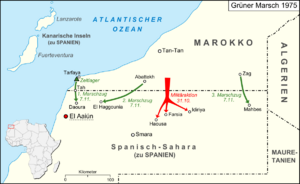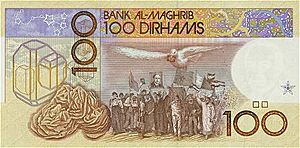Green March facts for kids
Quick facts for kids Green March |
|||||||||
|---|---|---|---|---|---|---|---|---|---|
 Marches of 7 November (in green) and military action of 31 October (in red) |
|||||||||
|
|||||||||
| Belligerents | |||||||||
| Commanders and leaders | |||||||||
| Units involved | |||||||||
|
Units of Tropas Nómadas Light cavalry groups of the Third and Fourth Thirds of the Legion Expeditionary battalion of the Canary Infantry Regiment 50 |
Royal Armed Forces | ||||||||
| Strength | |||||||||
| 5000 legionaries | 350,000 civilians 25,000 soldiers |
||||||||
The Green March was a big event in November 1975. The government of Morocco organized it to get Spain to give up control of a land called Spanish Sahara. Spain was getting ready to leave the area, as many European countries were giving up their colonies in Africa. The local people, called the Sahrawi people, wanted to create their own independent country.
About 350,000 Moroccans marched several kilometers into the Western Sahara territory. The international community, especially the United Nations Security Council, did not approve of the march. They saw it as a way to ignore a ruling from the International Court of Justice (ICJ).
Morocco later took control of most of the former Spanish Sahara and still holds it today. However, the Sahrawi people did not want to be part of Morocco. This led to the Western Sahara conflict, which is still not solved.
Contents
Why the March Happened
|
Part of a series on the
|
|---|
| History of Morocco |
 |
|
|
Classical to Late Antiquity
(8th century BC – 7th century AD) |
|
|
|
|
|
|
Related topics
|
Morocco, located north of Spanish Sahara, had long said that this land was historically part of Morocco. Mauritania, to the south, also claimed the territory. Since 1973, a group called the Polisario Front had been fighting Spain for independence. They were supported by Algeria. In October 1975, Spain quietly started talking with Polisario leaders about handing over power.
Morocco wanted the International Court of Justice (ICJ) to decide who owned the land. The ICJ gave its opinion on October 16, 1975. It said that there were some historical ties between certain Sahrawi tribes and the Sultan of Morocco. It also noted some ties between Mauritania and other Sahrawi tribes.
However, the ICJ also said that there were no strong ties of ownership between the territory and Morocco or Mauritania when Spain first took control. The court believed that the local people, the Sahrawis, were the true owners of the land. This meant they had the right to decide their own future. A UN team also found that most Sahrawis strongly wanted independence.
Despite this, King Hassan II of Morocco focused only on the part of the ICJ ruling that mentioned historical ties. He did not publicly mention the part about self-determination. Hours after the ICJ ruling, he announced the "Green March." He said it would "reunite" the land with Morocco.
To prepare for the march, the Moroccan Army entered the northeast part of the region on October 31. They faced strong resistance from the Polisario, which had been fighting for independence for two years.
The Green March Event

The Green March was a very large and well-known march. On November 6, 1975, about 350,000 unarmed Moroccans gathered in Tarfaya, a city in southern Morocco. They waited for a signal from King Hassan II to cross into the Saguia El Hamra region.
The marchers carried Moroccan flags and copies of the Qur'an. They held banners that called for the "return of the Moroccan Sahara." The color green was chosen for the march's name as a symbol of Islam. When the marchers reached the border, the Spanish Armed Forces were told not to shoot to avoid violence. Spanish troops also cleared some areas that had been mined.
Morocco's Claims to the Land
Morocco believed it had the right to the land because its people had shown loyalty to the Moroccan sultan for centuries. The Moroccan government said this loyalty was a strong legal and political connection. For example, Sultan Hassan I led two trips in 1886 to stop foreign groups from entering the territory. He also officially appointed local leaders there.
Morocco also told the ICJ that it had collected taxes in the area, which showed its control. The Moroccan government also said it appointed local officials, like governors and military officers, and gave them specific tasks.
However, the International Court of Justice found that Morocco's actions did not show that it had full and exclusive control over Western Sahara. The court did agree that there were some legal ties of loyalty between the Sultan and some of the nomadic people in the territory. It also recognized that the Sultan had some authority over these tribes.
The Madrid Agreements
The Green March happened when Spain was facing a big political problem. General Francisco Franco, who had led Spain for 36 years, was dying. Even though Spain's military in Western Sahara was much stronger than Morocco's, the Spanish government worried about a war. They feared it could cause major political changes or social unrest in Spain.
Prince Juan Carlos I, who was acting as Head of State, and Prime Minister Carlos Arias Navarro did not want trouble in the colony. Just a year before, the government in Portugal had been overthrown after getting stuck in colonial wars. So, after the Green March, Spain decided to talk directly with Morocco and Mauritania to avoid war and protect its interests.
Under pressure from Morocco, Spain agreed that no representatives from the local Sahrawi people would be at these talks. These talks led to the Madrid Accords on November 14. This agreement divided Spanish Sahara between Mauritania and Morocco. Spain agreed to give up the colony to Morocco and Mauritania. However, the agreement stated that the wishes of the Saharan people had to be respected.
Spain received a 35% share in the phosphate mines of Bou Craa and rights to fish offshore. Morocco and Mauritania then officially took over the parts they were given. Morocco claimed the northern part, and Mauritania took the southern third. Mauritania later gave up its claim in August 1979. This area was then quickly taken by Morocco.
The Polisario, now strongly supported by Algeria, rejected the Madrid Accords. They demanded that the ICJ's opinion on Sahrawi self-determination be followed. This led to a conflict between the Polisario and the Moroccan government. This conflict is still not resolved.
There is currently a cease-fire (a stop to fighting) in place. This happened after an agreement in 1991 to solve the dispute with a referendum (a public vote) on independence. A UN peacekeeping mission (MINURSO) is in charge of overseeing the cease-fire and organizing the referendum. However, the referendum has not yet happened. Morocco rejected the idea of a referendum in 2000. It has suggested a plan for Western Sahara to be an autonomous region within Morocco. The Polisario and Algeria have rejected this idea.
Spain is in a difficult position. It wants to keep good relations with Morocco, its neighbor. But it also has a responsibility as the former colonial power to follow international law. Spain's traditional position was that the wishes of the Western Saharan people must be respected. It supported the UN's call for a referendum. However, in 2022, Prime Minister Pedro Sánchez announced that Spain would support Morocco's autonomy plan.
See also
 In Spanish: Invasión marroquí del Sahara español para niños
In Spanish: Invasión marroquí del Sahara español para niños
- History of Western Sahara
- List of Spanish colonial wars in Morocco

